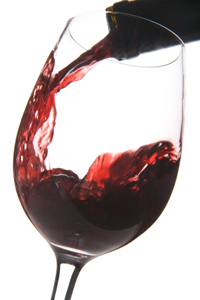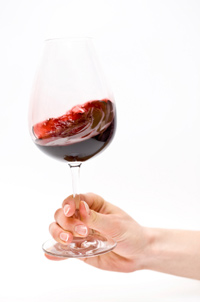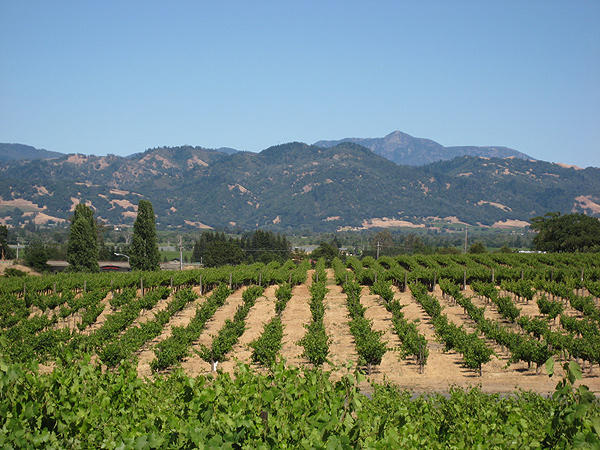By: John St. Mark
What’s the right way to taste wine?
Here’s the first thing you should remember: If you’re enjoying it, then whatever you’re doing works. You’re doing it right.
Analytic tasting techniques (like swirling and sniffing) are helpful if your goal is to maximize the amount of objective information you obtain from the wine. Not everyone is interested in that sort of information, but if you like to talk meaningfully about your wine, or to compare it with wines you have tasted on other occasions, it can be very useful. Here are some of the basics:
Room Temperature? Which Room are we talking about?
 Start by pouring the wine at an appropriate temperature. Very generally, whites should be chilled to somewhere around fifty degrees Fahrenheit. That is warmer than a normal refrigerator, but colder than a normal room; if you’ve had it in the refrigerator for a while, give it a few minutes to warm up before tasting (if it is too cold, you won’t get much aroma or flavor.) If you need to cool it down in a hurry consider using an ice bucket, and remember to fill it with both ice and water. Water between the ice cubes will conduct temperature much more efficiently than air.
Start by pouring the wine at an appropriate temperature. Very generally, whites should be chilled to somewhere around fifty degrees Fahrenheit. That is warmer than a normal refrigerator, but colder than a normal room; if you’ve had it in the refrigerator for a while, give it a few minutes to warm up before tasting (if it is too cold, you won’t get much aroma or flavor.) If you need to cool it down in a hurry consider using an ice bucket, and remember to fill it with both ice and water. Water between the ice cubes will conduct temperature much more efficiently than air.
People talk about "room temperature" for red wine, but that’s not very specific, is it? I like my red wine somewhere in the low-to-mid sixties. Much colder and the acid and tannin can overpower the more appealing characteristics. On the other hand, when the temperature gets up into the seventies or higher, alcohol will evaporate massively and can dominate the aroma. Wine that feels warm in the mouth can take on an odd, soupy character. If you don’t have a specialized refrigerator, and want to cool your wine down a little, just leave it in the regular refrigerator for a short time (maybe ten to twenty minutes, depending on the outside temperature) before opening it.
Use glassware that will allow you to appreciate all of the wine’s attributes. Clear, smooth glass is preferable; colored or opaque glass will mask the wine’s color. Cut crystal can be beautiful, but distracting, and typically these glasses are not shaped to optimize our perception of aroma. Glasses should taper inward toward the top. More space in the glass will allow for more aeration, and a narrow opening at the lip will retain aromatic vapor. A long stem will permit you to hold the wine without obstructing your view of its appearance, and will keep some distance between the wine and the warming influence of your hand. A smaller bowl for white wine will keep it in a more compact shape and help maintain a cooler temperature; a larger bowl for red wine will allow more rapid aeration and retain more aroma in the glass.
Is the glass half full or half empty?
Don’t fill the glasses too high; give yourself room to swirl! Most well-designed wine glasses are meant to be filled to the widest point in the bowl, which should be somewhere below the mid-point. This will maximize the interface between the wine and the air. A wide variety of glass shapes are available; some are traditionally associated with regions where particular styles of wine developed. What you use is up to your own personal preference, of course, but consider using good quality glasses in a style intended for the sort of wine you will be drinking; I bet you will like way they work together.
It looks like wine …
Once the wine has been poured, the first step is visual analysis. Look at the color, density and brightness. This can give you a lot of information, but let’s keep it simple for now. The color, for example, can tell you something about the wine’s evolution. A young white wine should have a very pale yellow color; it may even look slightly silvery or have a greenish tinge. As it ages it will get darker and more golden, and eventually it will turn a sort of amber color. A young red wine will have a purplish color, and as it ages it will turn ruby red, then develop a brick-red color, and eventually turn a sort of brownish red, and finally amber-brown. Holding the glass at an angle, over a white surface under good light, will help you discern these variations in color. Tilting your glass will give you a better look at the meniscus, the edge where the wine is thinnest and the colors appear to separate, and where the color evolution is most evident.
The older the wine, the better?
The wine’s age does not necessarily correspond to its quality. Not all wines benefit from long-term aging, and not everyone prefers the flavor of older wine. Very generally, a younger wine will tend to have bolder flavors, and an older wine will have more integrated flavors (and softer tannins in the case of reds.) The fresh, fruity characteristics will fade with time, so if they are the wine’s principal charm, it might be more enjoyable sooner rather than later.
The next thing we want to evaluate is the aroma. The wine has already spent some time in your glass as you looked at the color; now give it a sniff. Get your nose right up into the glass! Inhale through your nose and exhale through your mouth. Give some thought to what you perceive. At this point it may be helpful to think about general categories such as fruity, herbaceous, animal, earthy, chemical, and so forth. Now, give the wine a vigorous swirl (if you’re worried about sloshing and spilling, leave the glass on the table and move the base in a circular motion using two fingers) and repeat the sniffing. Think about more specific aromas within the categories you have identified. There is a lot to be said about aroma and its analysis (we can address this topic in a future column) but once again let’s begin with a simple idea: swirling will aerate the wine, and alcohol will evaporate. This evaporation will release aromatic compounds into the air, and the aroma will be amplified; that will help you identify component aromas.

Ready to taste? Start with a very small sip, and don’t be too judgmental at first. Initially, things like acid, alcohol, and tannin can overwhelm the more pleasant flavors. Give yourself a moment to get used to the wine. Notice the mouthfeel. Is the wine astringent, smooth, viscous, watery…? These characteristics are not the same as taste or flavor; you feel them in your mouth rather than taste them. We tend to use "taste" and "flavor" interchangeably, but technically, the meanings are different. Taste refers specifically to a limited set of things we perceive only in the mouth: sweet, sour, salty, bitter and, more controversially, umami (Umami is a Japanese term, sometimes translated as "savoriness." Chemically, umami is associated with glutamates. That is not something we need to be concerned with here.) We can’t smell tastes; sometimes we think we can because we perceive aromas associated with things that have strong tastes, but we can’t smell the sweetness, saltiness, sourness, etc. Flavor includes both the pure tastes and the aromas we perceive (using the retronasal channel) when the wine is in the mouth. That can be quite complex; your familiarity with the aroma can give you some guidance regarding what to look for in the flavor.
Many people find that slurping a little air along with the wine helps them to discern flavor. If you are tasting by yourself, or in the company of serious wine enthusiasts, then by all means give it a try, but I wouldn’t do it in a social setting where the wine is not the primary focus of attention. Good wine should enhance the time you share with friends and loved ones so don’t be annoying!
Remember, you don’t need to follow anyone else’s rules; taste, experiment, see what works for you, and enjoy!

Napa Valley Vineyard

















